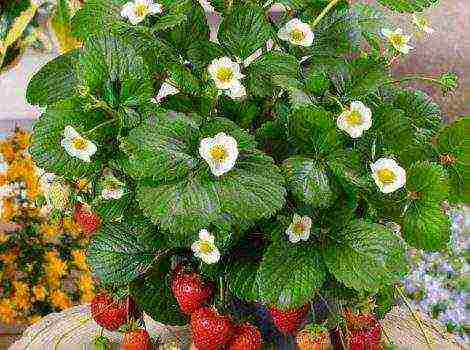Content
- 1 Moscow seedlings or how to grow tomato seedlings on toilet paper and in a plastic bag
- 2 Growing seeds on toilet paper: a step-by-step description
- 3 Growing seedlings in plastic bottles on toilet paper
- 4 Growing petunia on toilet paper: method
- 5 Benefits of growing seedlings without soil on toilet paper
- 6 Disadvantages of the method of growing seedlings without soil on toilet paper
- 7 What seedlings can be grown on toilet paper
- 8 Growing seedlings without soil on toilet paper
- 9 Growing seedlings in toilet paper by snails
- 10 Seedlings without soil on toilet paper video
Once I came across an interesting method of growing seedlings called "Moscow-style seedlings." Another name is seedlings on toilet paper, seedlings in a plastic bag, etc. Here is this newspaper clipping:
I wanted to try to grow tomato seedlings in such an interesting way, especially since the author of the note assured that even those seeds that have expired are pecking out, the sprouts are strong, do not get sick with a black leg, etc. But the biggest plus is that you do not need to mess with the earth and the space is minimal.

So, I needed:
- roll of toilet paper;
- cellophane bag - 2 pcs.;
- plastic glass;
- water;
- scissors;
- spray bottle with water;
- a bag of seeds;
- gum for pharmacy or for hair
- mineral and organic fertilizer for seeds and seedlings.

Moscow seedlings or how to grow tomato seedlings on toilet paper and in a plastic bag
The whole process takes a matter of minutes. We need to cut one of the cellophane bags so that we get long strips a little more than the width of toilet paper, about 10 cm. The length of the strip depends on the number of seeds, preferably not too long.
We lay out the cellophane strip on the table, lay a layer of toilet paper on top,
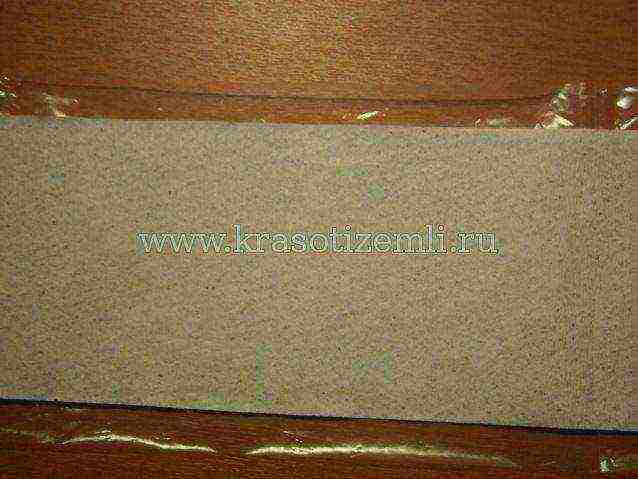
spray with water from a spray bottle,
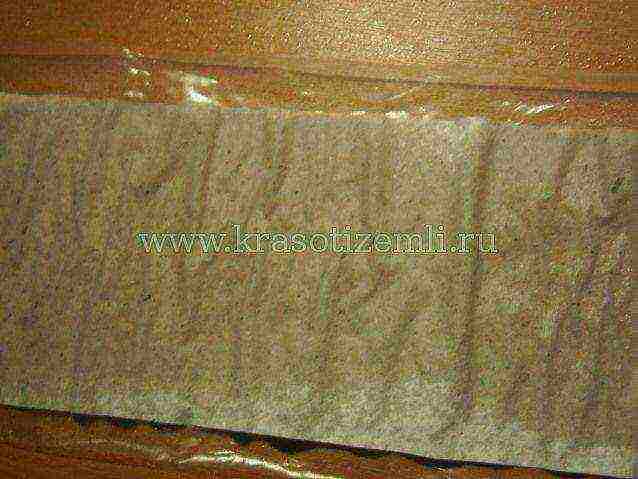
we lay out the seeds in such a way that from the top edge it is about 1.5-2 cm. Between the seeds - 2-3 cm.
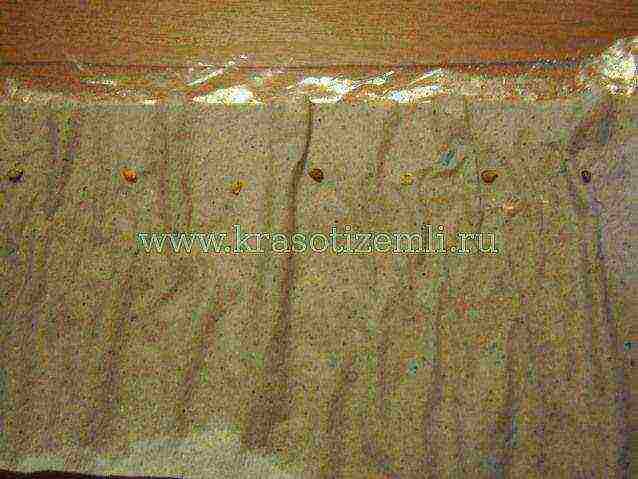
Cover the top with a strip of toilet paper, sprinkle with water from a spray bottle,
and then cover with a strip of polyethylene (cellophane).
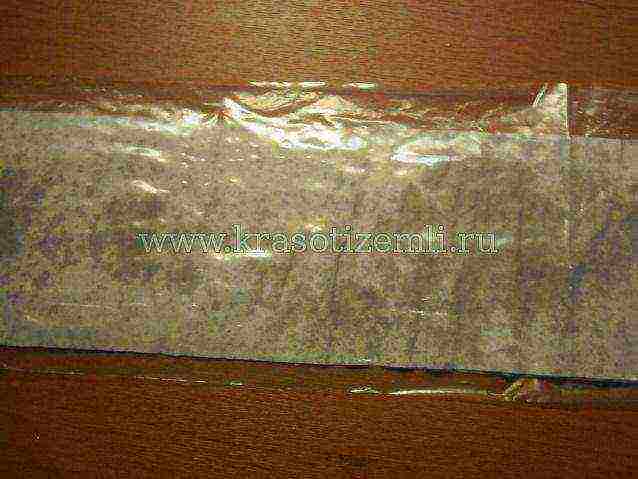
The result is a multi-layer strip, which should be carefully rolled into a tube and fixed from below with an elastic band. If you grow several varieties of tomatoes or several crops at the same time, you should make several of these tubes and attach a name to each, as well as sign the start date of germination.
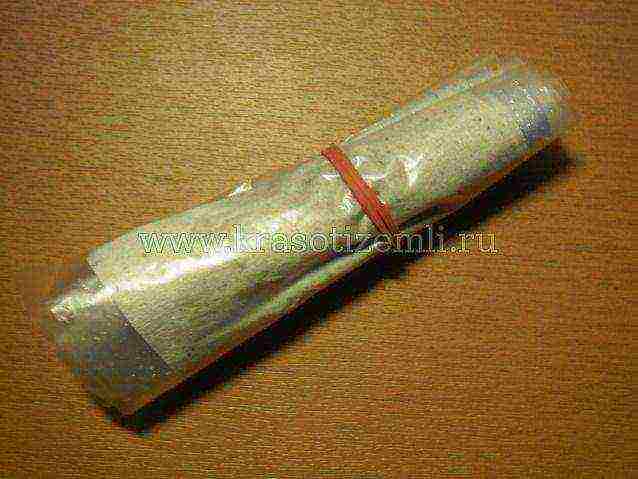
Pour water 2 cm high into a plastic glass, arrange the bags. Be sure to make sure the bottom edge of the toilet paper is in contact with the water in the glass.
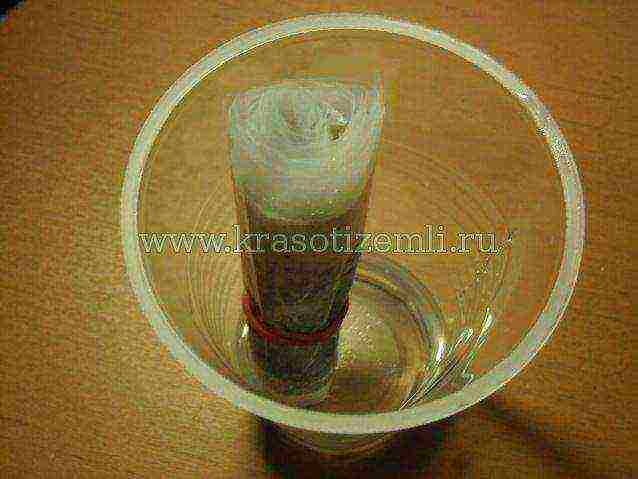
Cover the glass with a second plastic bag and put it in a warm place. When I was sprouting seeds in toilet paper, the central heating was still on. My tomato seeds sprouted on day 5. As soon as the first leaves turned green, I removed the top package. I changed the water in the glass every 2-3 days. A week after the first appearance of green leaves, mineral fertilizer for seedlings was added to the water in a glass according to the instructions on the package.

You can dive and plant sprouts in the ground when 3-4 leaves appear. But I delayed this moment a little. What made me happy - this did not affect the seedlings - only the roots stretched out, which I carefully cut when diving. All that needs to be done to plant seedlings in the ground is to unwind the bag, carefully separate each sprout, pinch the roots and can be planted in flower pots in a universal seedling soil mixture.
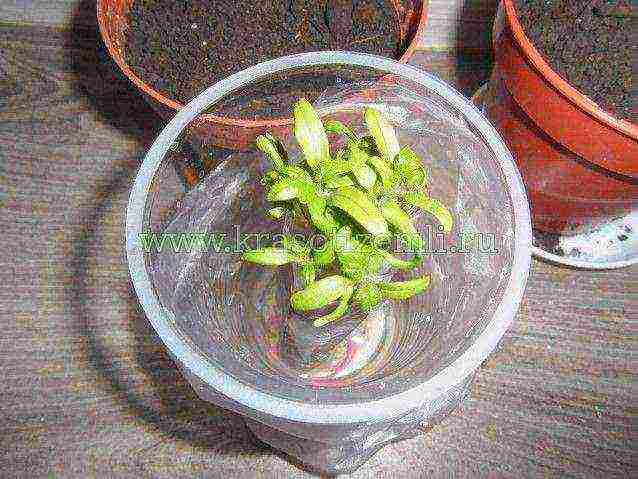

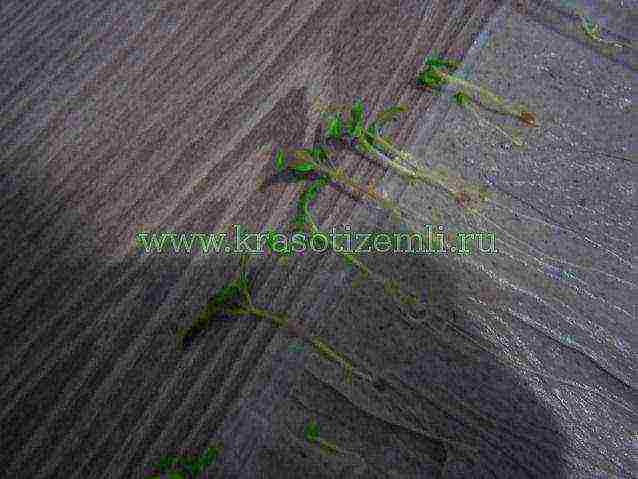
In this way, peppers, tomatoes, cabbage, eggplants, cucumbers and even flower seedlings can be grown.
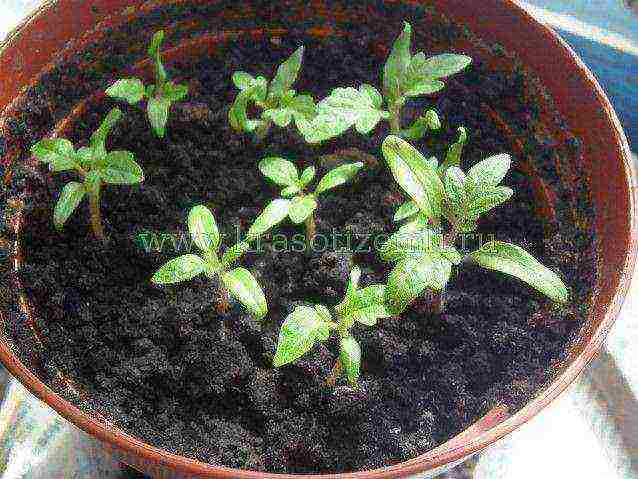

At first, I was skeptical about the method of growing seedlings in toilet paper and a plastic bag. And now I put the next glass of hot pepper seeds for growing seedlings in Moscow.
Did you like the material? It's easy to thank! We would be very grateful if you share this article on social networks:
Total comments:
The method of obtaining seedlings is interesting, but all the same, you cannot do without land, because in any case, the seedlings, as soon as they hatch, it is advisable to transfer them to pots with earth or cups, they will not stand for a long time on toilet paper, and in pots they can be stored even in the case of frost can wait there for some time.
In 2013, I also tested this method of growing seedlings. Yes, it would seem that the cultivation of seedlings is noticeably simplified, but ... There are also disadvantages to this method. For example, I don't dive tomatoes, because I live in the south of Russia, summer is usually hot and dry. If the seedlings are dived, the root will be lumpy, i.e. it will not grow deeper, and not dived tomatoes will stretch their roots deeper into the damp soil layers. So, I germinate the seeds and immediately send them to a large glass. In short, it makes no sense to me in this way, all the same, working with the land cannot be avoided. This is only if it is good if such seedlings, without transplanting into pots, are immediately planted in place, for example, in a greenhouse.
When growing seedlings, many gardeners are faced with such an unpleasant phenomenon as "black leg" - a fungal disease from which stem cuttings suffer. Moreover, this is a "childhood" disease, more mature plants are practically not susceptible to it. Affected seedlings have to be pulled out, and this can be very offensive, especially if the seeds are expensive. However, there is a great way to avoid such a nuisance, and it is suitable for almost all types of horticultural crops - sowing seeds not in the soil, but on toilet paper.
Growing seeds on toilet paper: step by step description
What else is good about this method - it is ideal for those who constantly live in an apartment, and with the arrival of heat, "move" to the country or plant a small garden on the balcony. The fact is that when using toilet paper for sprouting, you do not have to clutter up the house with pots and boxes, the space saving is obvious. In addition, most seeds need humid air for germination, and since they usually have to be sown during the height of the heating season, maintaining the required moisture regime can be a problem. But if you germinate seeds on toilet paper in plastic containers, the microclimate issue is solved by itself.
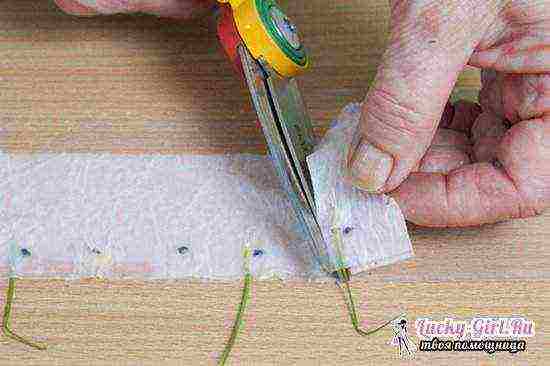

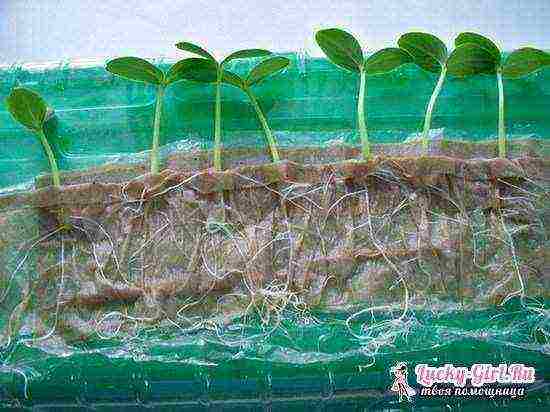
And now for more details.
In addition to toilet paper, you will need polyethylene (film can be, bags can be used), plastic cups or containers (for example, from under cakes) and a spray bottle.
- We prepare the base - we cut the polyethylene into strips about 10 cm wide.
- We put a layer of toilet paper on a polyethylene base.
- Wet the paper liberally.
- At a distance of about 1-1.5 cm from the edge of the toilet paper, lay out the seeds, leaving 3-4 cm gaps between them.
- We put another layer of toilet paper on top of the seeds and thoroughly moisten it from the spray bottle.
- We put another plastic strip on top of the toilet paper layer.
- We roll it up (make sure that the layers do not move relative to each other if possible) and fasten it with a thread or elastic band.
- Thus, we sow all the seeds that are needed in several rolls. Remember to attach a crop name tag to each roll.
- Place the rolls in a plastic container (seeds up), pour a little water into it (about 2-3 cm), close the lid and leave in a lighted place, for example, on the windowsill.
- Do not forget to add water to the container as needed.
After the shoots appear, it is advisable to feed them. The time of the first pick comes with the appearance of the 2nd or 3rd true leaf. In this case, you do not need to separate the roots from the toilet paper - just unfold the roll and cut off the seedlings right along with the paper, and then transfer them to the prepared container.This way you will not damage the still fragile plant.
Growing seedlings in plastic bottles on toilet paper
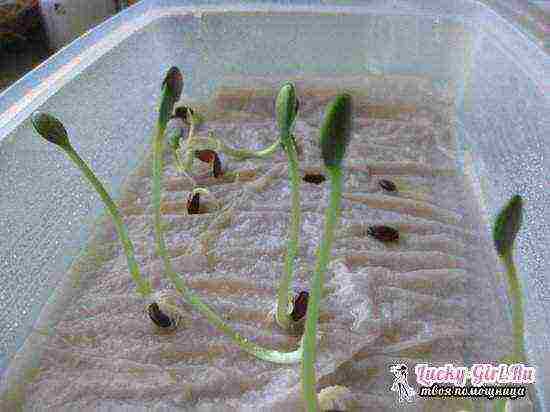
A plastic bottle, if you cut it in half (leave the bottom), can be used as a container, that is, you can put a roll of polyethylene and toilet paper with seeds in it. In this case, you need to ensure that the roll does not unwind, that is, it should "sit" tightly enough in the plastic bottle.
However, there is an easier way to plant seeds on toilet paper using a plastic bottle. It needs to be cut in half lengthwise, lined with several layers of toilet paper, moistened well, put the seeds on the paper and wrap half of the bottle with polyethylene. Such a mini-greenhouse is placed on the sunny side.
What is good about this method is that you do not need to water the seedlings, since its own microclimate is created inside the bottle, with a sufficiently high humidity.
Growing petunias on toilet paper: way
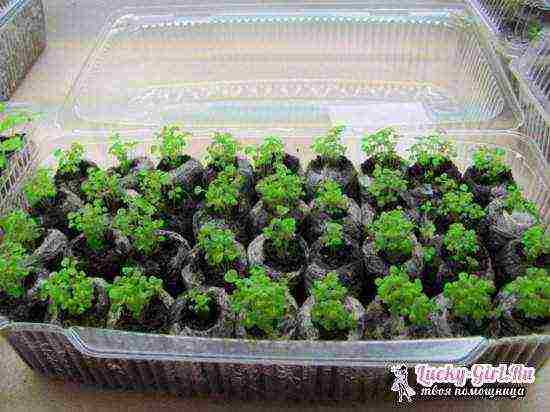
Petunia is a very moody plant. Without sufficient experience, rarely does anyone manage to grow viable seedlings from seeds, and most of our compatriots buy already adult plants for their balconies and flower beds. However, there is a method thanks to which it is possible to grow petunia seedlings with success even in an apartment.
You need to take a plastic container with a lid, lay toilet paper or paper napkin on the bottom, moisten it abundantly and put the seeds directly on the paper. Sprinkle the seeds on top with water from a spray bottle, cover the container with a lid and place in a well-lit warm place.
Make sure that the napkin does not dry out, and the seedlings will not be long in coming. On the 3-4th day after sprouting, the sprouts need to be carefully transplanted into peat tablets with the help of a toothpick, in which they continue to grow.
Growing seedlings on toilet paper is a very simple, economical and effective way. However, remember that the plants need your care even after you transplant the seedlings to a permanent place. Treat them with love, and they cannot help but respond to this with active growth, beautiful flowering or high yields.
Growing seedlings is a troublesome process, every gardener tries to find some innovation that will significantly facilitate it. A new way that would reduce costs, save space and time, and maximally protect against possible development difficulties.
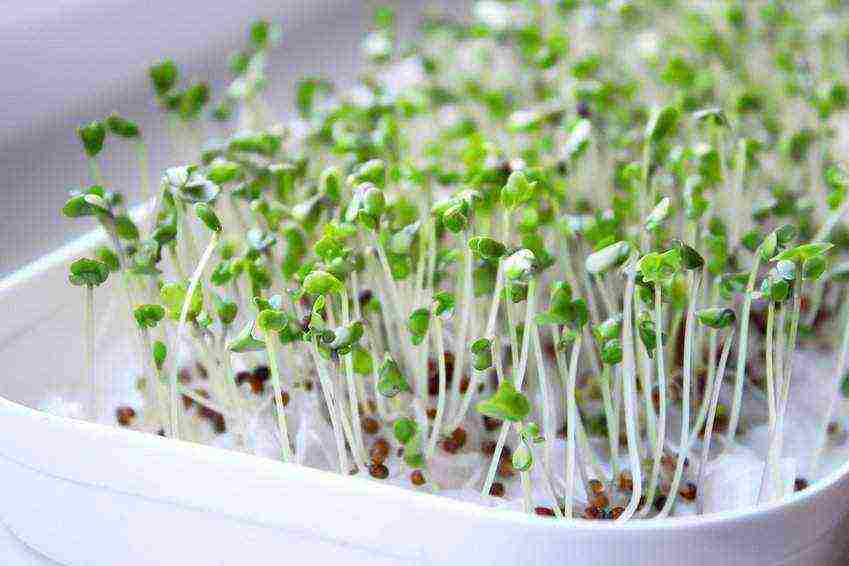
Benefits of growing seedlings without soil on toilet paper
Each method of growing seedlings has its own advantages and disadvantages. The advantages of sowing seedlings without soil on toilet paper are as follows:
- Due to the lack of contact of crops with the ground, the possibility of plant disease with a black leg is completely excluded.
- Seedlings in disposable cups significantly reduce the required space, which is almost always in short supply in the apartment.
- This technique is optimal for cold-resistant plants that can dive into the ground immediately after the first leaves are born.
- Some plants, for example, peppers and tomatoes, the seedlings of which should be small and strong, after growing in the Moscow way, take root better.
Fresh articles about garden and vegetable garden
Disadvantages of the method of growing seedlings without soil on toilet paper
Any method of growing seedlings has both positive and negative qualities:
- Due to the lack of light, plants that love warmth and light slowly develop.
- In toilet paper, the rhizome of the plant develops poorly, and the trunks are strongly stretched.
- Heat-loving plants, after germination in rolls and before planting in the chosen place, must be additionally grown in small pots with soil (like ordinary seedlings).
There are not so many drawbacks in seedlings grown by the Moscow method, and they are not significant. But the advantages of this method are visible, even to inexperienced gardeners.
The Moscow method can be used to grow seedlings of annual and perennial flowers that require this approach, various varieties of tomatoes and peppers, eggplants, all varieties of cabbage, onions and many other vegetables. Any novice gardener can cope with the planting technology. Plants grow sturdy and can thrive on their own under suitable climatic conditions.
What seedlings can be grown on toilet paper
The technique, which is also called Moscow, is ideal for people who live in cramped apartments, because it is simple and inexpensive. This method is best used for vegetables and certain types of flowers. With its help, you will be able to grow the following crops:
- cabbage;
- pepper;
- celery;
- eggplant;
- onion;
- melons;
- watermelons;
- pumpkin;
- tomatoes;
- strawberries;
- cucumbers;
- zucchini;
- petunia.
Growing seedlings without soil on toilet paper
This landless technology requires a minimum of materials and time. You will need a five liter plastic bottle, a plastic bag, and a roll of toilet paper or tissue paper. The bottle must be transparent. This method is convenient for seeds that are difficult to germinate (for example, strawberries or petunia). In addition, as soon as the sprouts grow the cotyledonous leaves, the root system immediately starts growing, and this increases the "vitality" of the plants. Seedlings quickly take root in the ground and develop very well. Seedlings in a bottle are grown as follows: Cut a plastic bottle in half lengthwise and put 7 - 8 layers of toilet paper or paper napkins in one of the halves. We moisten the paper well and let the water drain so that it does not remain in the bottle. Sow the seeds superficially, lightly pressing them to the paper. You can use a spoon or other handy object for this. We place the bottle with seeds in a plastic bag and tie it tightly, creating an impromptu "greenhouse". Do not open or water the bag within 3 weeks. The moisture from the condensation will be enough for the seeds. After the seedlings develop roots well enough, you can transplant them into the ground.
Such growing methods can be applied to almost all plants that germinate for seedlings: from vegetables to flowers. By researching and improving the method of growing seedlings on toilet paper, it can also be applied to root plants such as beets, or even pumpkin plants (squash, pumpkin, cucumber, squash). This is especially true for residents of the northern cities of the country, where summer comes late and ends quickly, and the germination of these crops for seedlings accelerates their development in an open area.

Growing seedlings in toilet paper by snails
The "snail" is formed by rolling a soft substrate under the laminate with a spiral. More than a dozen seeds are planted in it. For production, you need a substrate about 3 mm thick, cut into long strips about 10 cm wide. For sowing seeds, you will also need a transparent low container to accommodate a roll, two rubber bands, a cellophane bag, toilet paper and seed. Any plants can be grown in a "snail" if no light is needed to germinate their seeds.
Having freed up little space on the windowsill on the sunny side, it is possible to sow seedlings with this method.
We cut domestic bags into strips of the same width as toilet paper, approximately 1 cm. The length will be limited by the length of the bag.
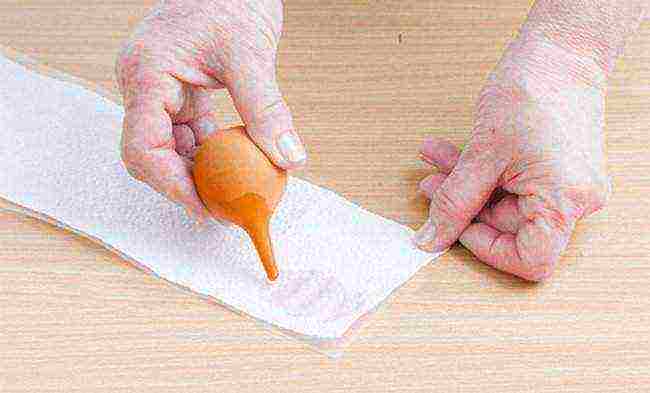
We cut the bottle so that there is a glass. Perhaps, it goes without saying, use a glass. But the idea of this method is to maximize the use of human waste. So, we give the bottle a second life.
We lay out the plastic tape on the table. Place a tape of paper on it. Sprinkle toilet paper with water.

From the top edge we go down 1 cm.We carefully lay out the seeds along the width of the tape so that the distance between them is 2-3 cm.
We cover with another layer of paper and again with tape from the bag.
We slowly wind it into a roll, and so that the finished bundle fits into a cut bottle. The seeds should appear at the top of the clear cup, closer to the light.
Pour about 2 cm of water into the bottle and put it on a warm, bright place. Sometimes it is necessary to add water and after 10 days you will be pleased with a wonderful green bouquet on the windowsill!
Fresh articles about garden and vegetable garden
This method is very convenient for diving. At a time when two or three leaves are already delighting us with their own fresh greens, it is possible to reach for the roll, unwind it, remove the film and see which specific sprouts are stronger. After that, carefully cut the bottom film with scissors, separating the seedlings from each other.
It is possible to transplant green babies directly in soggy toilet paper, it will slowly dissolve in the ground.

When diving seedlings, do not try to apply 100 percent of the seedlings. Choose the most developed, since the methods given above allow you to do this smoothly, since both the roots and the stem are visible under the film. And do not forget, when transplanting, it is better to follow the rule: for seedlings 4 days old, a space of 10 by 10 cm is needed.
Seedlings without soil on toilet paper video
Seedlings of toilet paper - is it possible? As practice shows, it is not only possible, but also convenient. From the article you will understand how seeds germinate in plastic bottles. And also, read about how entrances grow without soil, in toilet paper. From the video you will learn all the intricacies of this popular method of growing seedlings.
Paper, bottle and polyethylene instead of soil
In the spring, the gardener has a lot of worries, because it is necessary not only to provide seedlings, but also to fully prepare the site for the warm season. It is human nature to simplify everything, and when there is not enough time, even more so. There is, of course, an option, to buy absolutely ready-made seedlings on the market, but then it will not be possible to control the varieties, the percentage of germination, to check which type of growing seedlings will suit you more. So the people came up with the idea of growing seedlings, minimizing time and economic costs. Moreover, they use only toilet paper, a bottle and polyethylene.
To grow seedlings, you only need a bottle, toilet paper and polyethylene
This is mainly done in two ways. They differ only in that you need to cut a plastic bottle along or across.
Seedlings in a plastic bottle, cut lengthwise
Attention! Whichever method you choose, the seeds should never be placed so close that they touch. Otherwise, the roots will get tangled!
To work you will need:
- flower or vegetable seeds;
- plastic bottle;
- white toilet paper;
- plastic bag.
Practitioners write that thanks to this method, plants can be watered less often than usual. So let's get started.
- Cut a transparent bottle with a capacity of one and a half liters in half along the length of the bottle.
- We put 6-8 layers of white toilet paper on one half. It must be moistened with a spray bottle so that there is no excess moisture.
- We put the seeds on the paper, moreover, lightly press them against the paper so that they lie like in holes.
- We put on a transparent bag on top of the entire bottle. It turns out a kind of greenhouse.
- You need to transplant the sprouts very carefully, with tweezers, separating them from neighboring sprouts, but not from the paper! We dive right with her.
Interestingly, the moisture evaporates, and then falls back down from the bag onto the toilet paper. Of course, sometimes you need to remove the bag and add water, but, as practitioners say, you need to water the paper much less often than the earth.
Seedlings in a plastic bottle, cut lengthwise
Plant breeders note the undoubted advantage of this method. Seedlings do not grow in height, they release only a couple of leaves, and then begin to develop the root system.Therefore, when transplanting, seedlings grown in a different way, only strengthen the root, and these seedlings immediately grow and begin to release leaves.
Seedlings in a plastic bottle cut across
Tip: Seeds must be sorted before planting. To do this, pour 1 liter into a bowl. water and stir in water 30 gr. salt. Pour the seeds from the bag into the solution. Those that surfaced - weed out. Dry the rest by laying out on paper, and you can start sowing.
You will need:
- seeds;
- several transparent plastic bags;
- plastic bottle;
- white toilet paper.
To germinate seeds, you can use both a bottle, cut across, and plastic cups
Having freed up some space on the windowsill on the sunny side, you can sow seedlings in this way.
- We cut our bags into strips of the same width as toilet paper, about 1 cm. The length will be limited by the length of the bag.
- We cut the bottle so that we get a glass. You can, of course, also use a glass. But the idea behind this method is to make the most of human waste. Thus, we give the bottle a second life.
- We lay out the plastic tape on the table. Place a tape of paper on it. Sprinkle toilet paper with water.
- From the top edge we go down 1 cm. Carefully lay out the seeds along the width of the tape so that the distance between them is 2-3 cm.
- We cover with another layer of paper and again with tape from the bag.
- We slowly wind it into a roll, and so that the finished bundle fits into the cut bottle. The seeds should be in the upper part of the transparent cup, closer to the light.
- Pour water into the bottle, about 2 cm. And put on a warm, bright place. From time to time you need to add water and after 10 days you will be pleased with a wonderful green bouquet on the windowsill!
- This method is very convenient for diving. When two or three leaves are already delighting us with their fresh greens, you can take out a roll, unwind it, remove the film and see which sprouts are stronger. Then, with scissors, carefully cut the bottom film, separating the seedlings from each other.
- You can transplant green babies directly in soggy toilet paper, it will gradually dissolve in the soil.
Attention! If you notice that the sky is gloomy for several days in a row, and your green pets are lacking in sunlight, take the weather into your own hands! Just put the seedling bottle under a fluorescent lamp for several hours every day.
When diving seedlings, do not try to use 100 percent of the seedlings. Choose the most developed, since the above methods allow you to do this without difficulty, because under the film you can see both the stem and roots. And remember, when transplanting, it is better to follow the rule: for seedlings 4 days old, you need a space of 10 by 10 cm.
Pros and cons of growing seedlings in toilet paper
Advantages:
- profitability. Thanks to these two methods, you can reduce the time for planting, and while the tender seedlings "hatch", start preparing the site. In addition, soil is not wasted and space is saved. After all, classic cups with sprouts take up much more space;
- purity. The earth does not crumble during planting, which means that these works are more hygienic;
- lack of disease. Due to the fact that the entrances are not in contact with the ground, the risk of infection by the black leg disappears;
- ease of use. Even a beginner who has neither the skills nor special containers or substrates for seedlings can cope;
- versatility. The method is suitable for any type of plant. Basically, tomatoes, cucumbers, onions and leeks, eggplants, peppers and even flowers, for example, marigolds, are sown in this way.
It is not recommended to place the seeds too often for the normal development of the root system.
Flaws:
- when using the second method, when the bottle is cut across, the seedlings may be too densely spaced.Then they will stretch upwards, and the roots will turn out weaker;
- if you completely cover a plastic bottle cut along the length (as in the first method) and do not regularly open the bag for ventilation, the seedlings may suffocate.
Germinating seeds in toilet paper - video


